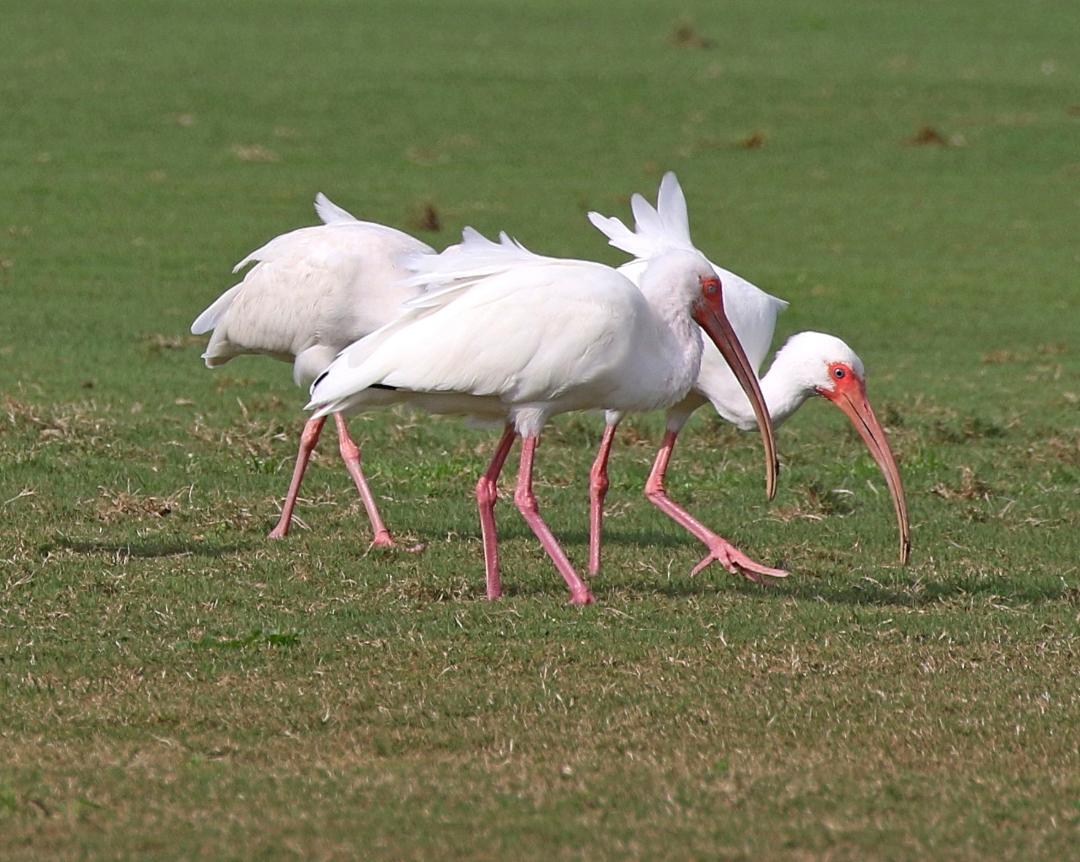photo by Charles Lorenz
Flexible, adaptable and unpredictable—that’s the American white ibis.
Primarily a Gulf Coast inhabitant of salt and freshwater mudflats, the white ibis also forages in pastures, lawns and flooded fields. It may breed as far northwest as Dallas, its variable nesting season and sites apparently dependent upon rainfall. White ibises occasionally pop up in such varied locales as New Jersey, Wyoming or California.
Every time I turn around, it seems I see a cluster of foraging white ibises, white heads bobbing—on Island mudflats, mangrove swamps and yards, at Lake Harlingen, Pendleton Park or residential lawns in Brownsville—enjoying a diverse diet that includes saltwater and freshwater crustaceans and fish, insects, snails and worms. But for weeks, I’ve spotted nary a one. Tree-loads of cackling snowy and great egrets now amass—arguing and snatching up sticks for nests at the Gladys Porter Zoo—and grunting cormorants jostle for space in the trees across the street, but no ibises.
Javier Gonzalez, Naturalist Educator at the South Padre Island Birding, Nature Center and Alligator Sanctuary, posits that white ibises are likely nesting alongside other wading birds on spoil islands (which have sprung up from dredging) or perhaps Green Island—which abounds in breeding waders— in the Laguna Madre, just north of the mouth of the Arroyo Colorado. Importantly, ibis chicks cannot digest saltwater prey, so the birds head inland, where they can catch freshwater creatures, and their sites may change from year-to-year.
The adult white ibis (Eudocrimus albus) is a white, long-necked, blue-eyed wading bird with black wingtips, visible in flight. Its long, decurved (downward curved) bill distinguishes it from fellow waders like egrets and herons. Its pinkish face and legs redden during breeding seasons, when both sexes also acquire a vivid red throat pouch, brighter and larger on females.
Normally a quiet bird, an ibis may deliver a hrunk hrunk hrunk as it takes flight. It honks or squeals during courtship and altercations and makes a huu-huu-huu sound while foraging. With neck and legs outstretched, it flies with strong, fast wingbeats mixed with glides. It may circle high or fly in lines as long as a mile.
The ibis’s genus, Eudocimus, derives from Greek “eudokimos”, meaning “glorious”, and its species name, Albus, in Latin, means “white”. Its only fellow genus member is the scarlet ibis from South America with which it sometimes interbreeds. (We can visit our zoo’s aviary to see scarlet ibises grazing, perching and flying). Interestingly, the other two ibises which appear occasionally in the Valley, the white-faced and the glossy, are in a different genus, Plegadis.
This ibis, which hunts by both sight and touch, forages in two to four-inch-deep water, often sweeping its head back and forth—much like a roseate spoonbill, its close relative—to detect prey, its eyes peering down its long bill. In seeming choreography, it—along with other waders, hoping to eat what’s been stirred up— walks forward, stops to preen or glance around, probes the mud, raises its bill to swallow, and continues. It touches and tastes with its ultra-sensitive bill tip. The ibis crushes shells and such in its mandibles and excises crab claws and some insect heads. It may stab, then slice large prey into smaller morsels with its bill. Ibises also readily steal food from each other, as well as from nestlings. Ibises, sociable birds, forage, roost and nest together and with other wading birds, sometimes in colonies of thousands.
White ibises tend towards monogamy, but males sometimes engage with extra females. When a mated male catches an offender, a struggle may ensue, resulting in bill thrusts, jabs, bites and yanking of feathers. A male may also peck the head and back of his seemingly faithless mate. Though white ibises rarely preen one another, they do so during courtship. To show his interest, a male, holding a twig in his bill, may point upwards and lower his head upon his back.
Ibises nest in or near crotches of trees and shrubs, often on inland islands or in swamps. Though the male may deliver sticks, the female constructs the nest. (Occasionally they steal one). Both birds incubate eggs, and they take turns protecting the helpless, closed-eyed, grayish newborns—some with a spray of white feathers springing from their crowns—which can die from the severe heat, cold or flooding we experience in early spring.
Nestlings lie down and sleep, eyes closed, for the first day or so. Then, a parent grasps a chick’s bill, prompting it to lift its head, and regurgitates food from its crop (a storage area beneath the throat) into the chick’s mouth. Later, a chick begs, making a zziu sound, and touches the base of a parent’s bill, flaps its wings and nestles its head within the bill, jerking and bobbing so the adult regurgitates. In the third week, chicks briefly exit the nest, and they begin to steal from one another. Soon flying lessons begin, and in about 40 days, the young have departed to roost with other adolescents or adults.
Though populations of white ibises fluctuate in any given area, this resilient bird’s population is currently holding steady. With our expanding populations of humans, though, we must assure that ibises have adequate wetlands, especially for nesting. Also, since breeding ibises are quite sensitive to disturbances, researchers are advised to visit nesting areas for no more than half an hour and on alternate days.

